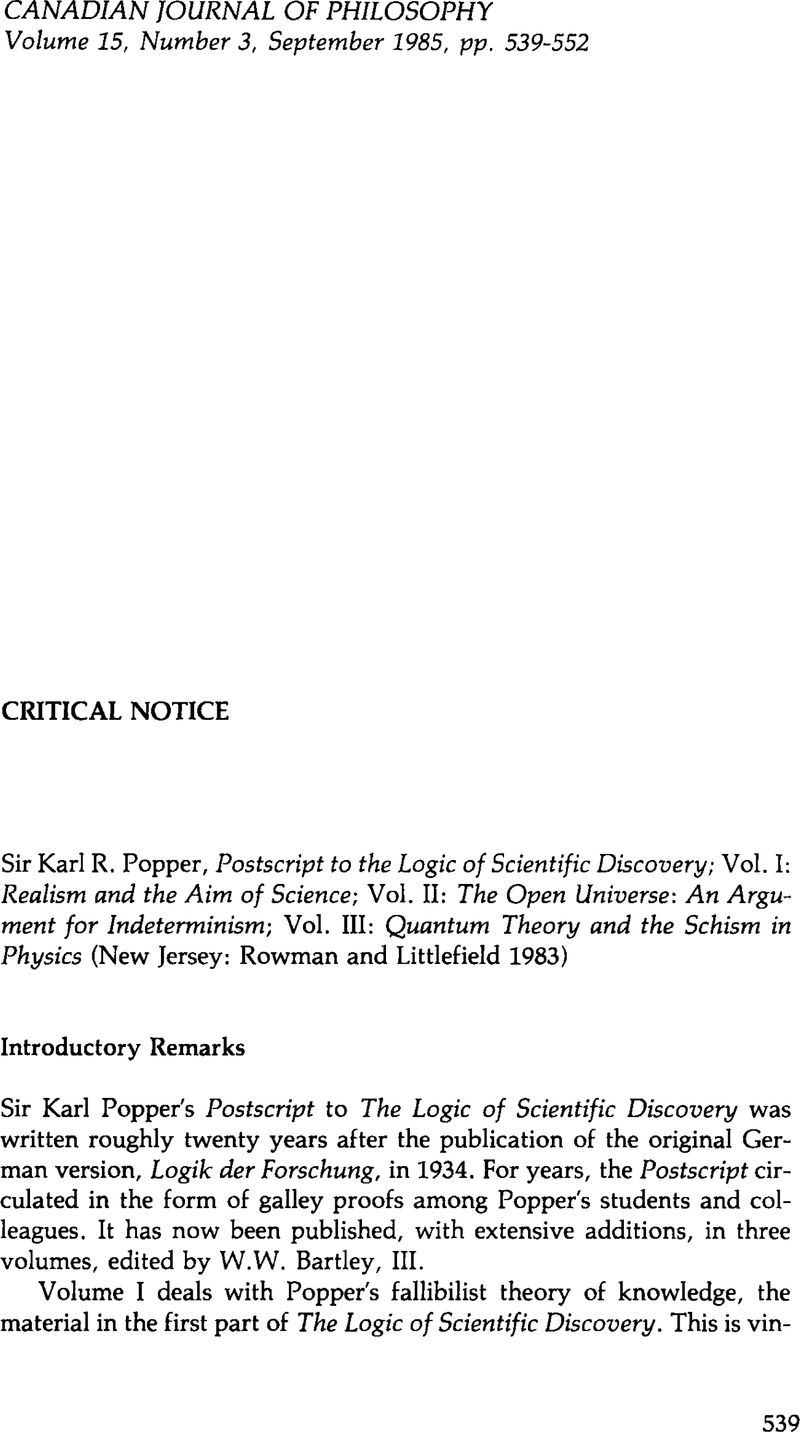Article contents
SirKarl R. Popper Postscript to the Logic of Scientific Discovery; Vol. I: Realism and the Aim of Science; Vol. II: The Open Universe: An Argument for Indeterminism; Vol. III: Quantum Theory and the Schism in Physics (New Jersey: Rowman and Littlefield 1983)
Review products
Published online by Cambridge University Press: 02 January 2020
Abstract

- Type
- Critical Notice
- Information
- Copyright
- Copyright © The Authors 1985
References
1 A. Church, ‘On the Concept of Random Sequences,’ Bull. Am. Math. Soc 46, 130, (1940). This result is valid only in conjunction with Church's famous thesis, viz., that ‘calculable’ means ‘recursive.’ The significance of the theorem is that it rules out the possibility of a deliberate, calculable ‘gambling system’: a truism has turned into a tautology (almost).
2 Similar suggestions were made independently by A.H. Copeland, ‘Admissable Numbers in the Theory of Probability,’ Am. l. Math. 50, 1928.
3 The proof is as follows: Let ﹛0,1﹜ω be the space of all 0,1 sequences with the uniform measure. Let x = (x1, … , xn, …) ∈ ﹛0,1﹜ω. We shall say that x ‘ converges’ if the limit of the relative frequencies of 1's in x exists; otherwise x ‘diverges.’ Since almost all sequences converge we can assume without loss of generality that every x ∈ A converges. For x = (x1, … , xn, … ). y = (y1, … , Yn' … ) ∈ ﹛0,1﹜w, put x+y = ﹛(xj+Yj) (mod 1)﹜∞ j=1 and x.y = ﹛xjyj﹜ ∞ j=1. The space ﹛0,1﹜ω with the operation + is a group (isomorphic to the circle group) and the measure is +- invariant. Now,
(x1+Yi) (mod 1) = xj(I-yj) + yj(I-xj)
for all j = 1,2, …. Hence if x, y, and x.y converge so does x+y. Let z E ﹛0,1﹜ω be such that z diverges. Since A has measure 1 we have A + A = ﹛x+ y | x,y, ∈ A﹜ = ﹛O,l﹜ω, and therefore there are x,y ∈ A for which x+y = z. Since x,y are assumed to converge it follows that x.y diverges. (To see that A+A = ﹛0,1﹜ω, suppose the contrary: there exists a sequence z∈A +A in ﹛0,1﹜ω which cannot be expressed as a sum of two sequences in A. Consider the set (z-A) ⋂ A, i.e., the set of all x∈A of the form z-y, where y∈A. It follows from our supposition that this set is empty, i.e., there do not exist sequences x, y∈A such that x=z-y (i.e., z=x+y). But A and z-A cannot be disjoint. A has measure 1 and the measure is +-invariant, so both these sets have measure 1.)
4 There is another considerably more sophisticated approach to randomness that is not mentioned by Popper. On this view, which is due to Kolmogorov, randomness of a finite sequence is defined in terms of its computational complexity. The relations between this concept and classical probability are not entirely clear. For a discussion, see T.L. Fine, Theories of Probability, (New York, NY: Academic Press 1973)
5 A mathematical example of a sequence of events for which there is a high probability of instability is given in I. Pitowsky, ‘On the Status of Statistical Inferences’ (forthcoming)
- 5
- Cited by


